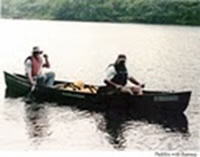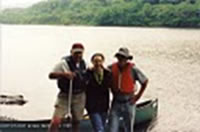
An Interview with a Coot in a Canoe: A Life of Defending Rivers and Writing about It
It was June 10, 2003. I was lying on a big, flat rock on the west bank of the Connecticut River just south of Bellows Falls. My old buddy Ramsay and I were canoeing the entire Connecticut River. After fourteen days and a lot of rain, this was the nicest day we'd had. The sky was blue, the sun bright, the temperature about to hit 90. We were taking a break after paddling around another of the river's big loops. The rock was hot and I was about to roll off into the river when I remembered what the Doc, a pathologist we'd stayed with the night before, had told me when I asked him if the river was suitable for swimming. "Do you like swimming in treated or untreated crap?" the Doc said. "The storm drains and sewer plants in towns like West Lebanon and Springfield use the same lines for water runoff and sewerage. When it rains, they divert everything directly into the river. When the weather's dry, the sewerage is treated. When it's wet, it's untreated. They're working to straighten it out, but treated or untreated, crap's still crap."
The Doc's warning ended any thoughts I had of going for a swim, but gave me a new one. "You know, Ramsay," I said, getting back into the canoe, "I've come to the conclusion that best definition of a truly civilized society is one where any kid at anytime can jump into any river for a swim."
"If that's the case," Ramsay said, pushing us off, "we've got a long way to go."
In 2003, career conservationist and author Dave Morine and his old business school friend Ramsay Peard paddled the Connecticut River from source to mouth in a canoe. Dave later wrote a book entitled "Two Coots in a Canoe." Here Dave talks about the trip, rivers and conservation.
"The idea for the trip began on a vacation from business school after Ramsay and I had just fallen out of a canoe into the Saco River in Maine. We were sitting on a rock in the middle of the river watching our canoe float downstream (we were arguably the worst paddlers in America)" Dave explained. But they graduated, got busy with their lives and careers, and forgot about it. Until, one day, after not seeing Ramsay in twenty years, Dave got a call from him pronouncing that it was finally time to take the trip. Says Dave, "I had the time, but it was a crazy idea. Here we were, two old guys, 59 and 60, talking about canoeing this whole river. So, of course, it seemed like the right thing to do. But I told Ramsay that I was too old to sleep on the ground and crap in the woods. Ramsay asked me what we would do. I thought about it for a minute and decided we would 'rely on the kindness of strangers.'
 So Dave and Ramsay contacted a local river conservation group, the Connecticut River Watershed Society, which sent word to its members that the two "coots" were coming down the river and needed a place to stay. Dave and Ramsay were soon overwhelmed with offers of hospitality.
So Dave and Ramsay contacted a local river conservation group, the Connecticut River Watershed Society, which sent word to its members that the two "coots" were coming down the river and needed a place to stay. Dave and Ramsay were soon overwhelmed with offers of hospitality.
26 days, 410 miles, 26 strangers (a different home every night) and $50,000 in conservation grants later (as part of the trip they had raised some money to award to local river–saving groups along the way) they entered Long Island Sound where the Connecticut joins the sea.
The trip gave Dave the chance to reflect on how he first got involved in conservation and what he learned over the years, much of which is in his book.
"After graduating from business school in 1969, I went to work for a company that was into recreational development in the Northeast. What they'd do was find old family estates on lakes and rivers and along the coast that had to be sold for one reason or another and bust them up. I was meeting with the heirs to one such estate. They all loved the property and wanted to see it saved, but had to sell it for tax purposes. In working with them, it became clear that they could make almost as much money by keeping the core area and the buildings for themselves and giving all the undeveloped land to a conservation group. That's the plan they chose, which promptly got me fired, but I didn't care because what I'd discovered is that saving land is a hell of a lot more fun than developing it."
 After his experience on the development side of the fence, in 1972 Dave went to work for The Nature Conservancy. "Back then, TNC was primarily a volunteer organization. I was its forty–third full–time staff member and its first Director of Land Acquisition. I held that job for eighteen years and during that time we completed over 5,000 individual projects totaling more than 3 million acres in 1,200 separate preserves scattered all across the US. "
After his experience on the development side of the fence, in 1972 Dave went to work for The Nature Conservancy. "Back then, TNC was primarily a volunteer organization. I was its forty–third full–time staff member and its first Director of Land Acquisition. I held that job for eighteen years and during that time we completed over 5,000 individual projects totaling more than 3 million acres in 1,200 separate preserves scattered all across the US. "
Dave eventually had an epiphany about what to preserve, "While TNC was constantly developing a national natural area inventory through its state heritage programs, my own criteria for selecting projects was quite simple: if it's wet, save it."
One of his favorite projects was saving 35,000 riparian acres in Mississippi, Says Dave, "By preserving the Pascagoula, Mississippi had done something no other state had ever accomplished, and while used to being labeled last in so many things, it suddenly had become a leader in conservation." As Dave puts it, "There is no question that rivers are the lifeblood of the planet."
He feels that Pogo, the possum and sage of the Okefenokee Swamp, had it right when he said, "We have met the enemy, and it is us." "When we portaged around dams that blocked falls that had once been the largest in the east, it felt like they had drained the power of the Connecticut itself, neutered it – because if there is a place on a river where it shows you who is boss, it is at the falls."
When asked for his main observation from the journey down the Connecticut Dave says: "It is a special river. The people were individual pearls, and the river, the necklace."


